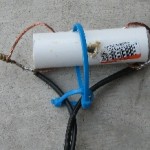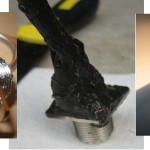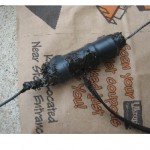After a bad experience with a commercial G5RV product, I decided to take the high road and put up a homebrew version. AI4FO was kind enough to do the initial work for me. He cut some stranded insulated wire to the right length (see his article) and attached some twin lead and insulators. I picked up from there.
I decided I wanted to make this thing last for a good while, so I made some modifications. The schedule 40 PVC used as the center insulator provided good support for the two 51 feet legs. Having seen ants and other creatures living in some of my open antenna spaces over the years, I decided this needed to be sealed up. Below you’ll see the center insulator before I got a hold of it.
I made my way to the hardware store and the local electronics supplier. My list included:
Silicon sealant (suitable for outdoor use)
Spray insulation
Spray paint appropriate for plastic
Big heat shrink tubing (1 ½)
Panel mount SO-239
Wire ties
First, I made certain all of the connections were electrically sound and soldered correctly. Using the multi meter frequently in a project like this is key to catching any screw ups.
I attached the panel mount SO-239 to the twin lead. I did this instead of just connecting the RG-8X to the twin lead because I had gone through great pain a couple of weeks prior soldering on a PL-259 outside to the coax. You’ll see that I took the twin lead, properly protected it with heat shrink, and attached it. Afterwards, I sealed it with silicon.
Then the mods to the center insulator began. I used the wire ties to strap the twin lead to the side. I took two pieces of the large heat shrink and covered as much of the PVC as possible. From there, I inserted some of the spray insulation and let it cure, then sealed the ends of the heat shrink with silicon.
I use the spray paint to make the end insulators (more PVC) more stealthy. The stuff I ended up with actually is a plastic coating paint – very similar to the stuff we would use to coat the end of rope in the fire service. A couple of coats really seals the pipe well and the black makes it hard to spot.
To sum things up:
1. We all know I am anal retentive about doing things nice and neat. Not quite as anal as Brad who in our younger teenage years would have a cow if you threw your tissue away in his recently emptied trash can, but none the less I like things a certain way. I wanted to make the life of this antenna as extended as possible.
2. Use your multi meter. I didn’t catch any shorts this time – but every connector you place or any antenna connection should be double checked – and rechecked when you mount or move.
3. If you have access to the antenna analyzer, use it.
4. And last but not least – use heat shrink – people. And make a multi layered approach with it when possible. Multiple sizes and layers make a better product with more protection in the end.
Now take a look and see if you can find this thing….Should have a series of pics up in my album this evening.





Pingback: A new G5RV for BPZ | FieldComm Association